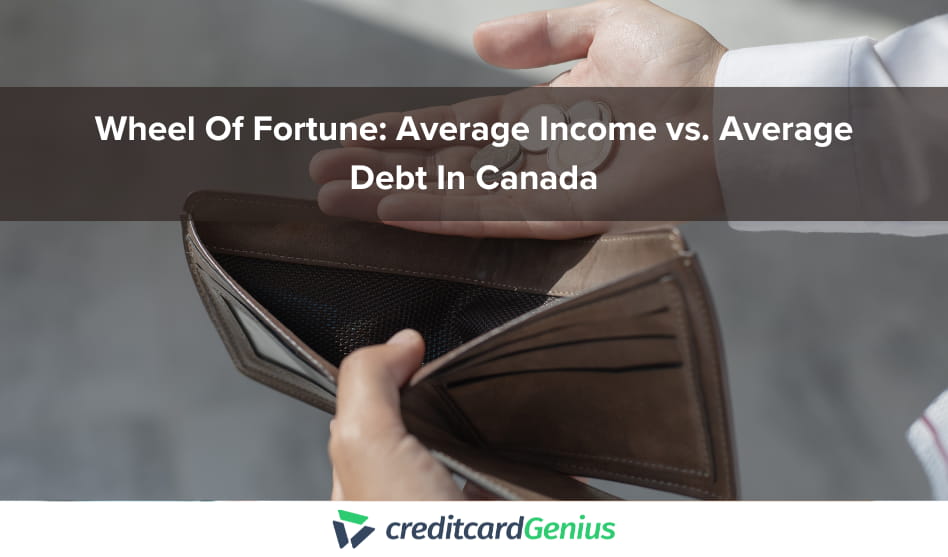Budget-savvy Canadians have practiced balancing their personal debts against their incomes for years, but the same can’t be said for the country’s debt and labour market. The average debt (including mortgages and credit card loans) has risen by 458% over the past 35 years, while for 99% of Canadians, the average income has only increased by 231%.
In this article, we explore the average household’s relationship to debt, as well as the relationship to debt held by various income groups.
Key Takeaways
- The average Canadian tax filer holds $94,442 in debt (including a $373,118 mortgage and a credit card balance of $4,681) and makes an average income of $53,972 per year.
- From 1990 – 2025, the average personal debt for 99% of tax filers increased by 458%, while the average income increased by 231%.
- The bottom 99% of Canadians currently holds an average debt-to-income ratio of 1.75.
Never miss an amazing deal again + get our bonus 250+ page eBook for FREE. Join 50,000 other Canadians who receive our weekly newsletter – learn more.
What is the average Canadian debt?
As of 2022, the average debt in Canada stands at $90,989 per person 15+, including personal loans, credit cards, lines of credit, and residential and non-residential mortgages. That’s $3.061 trillion of total private household debt divided among an estimated 31,211,000 people in the last quarter of 2022, an increase of 471% (or $71,665) since 1990.
The greatest year-to-year changes in debt occurred between 2007 – 2008 and 2021 – 2022, which marked the years of the Great Recession and COVID-19. During these periods, Canadians took on an average of $4,443 and $5,087 more debt per year, respectively.
Unsurprisingly, the rate of inflation has kept in lockstep with the average debt, growing a total of 105% over the same 35-year period:
According to the Consumer Price Index (CPI), the 3 largest purchase categories – shelter, food, and transportation – each increased in price by over 120%. The greatest year-to-year changes in inflation were 2021 – 2022 and 2022 – 2023, each of which saw an increase in prices of more than 10%.
As you can probably guess, the primary accelerators of debt in Canada are mortgage loans. If the nation’s total private debt belonged to a single household, 74.4% would be tied to a mortgage, compared to 63.3% in 1990.
As for the average size of those debts (divided among the number of debts, not the number of Canadians), TransUnion reports that in 2024:
- The average mortgage was $373,118
- The average line of credit was $35,190
- The average auto loan was $29,656
- The average credit card debt in Canada was $4,681
Each category was at least 3% higher than its counterpart recorded in 2023.
How much money does the average Canadian make?
In 2022, the average total income per person 15+ in Canada was $63,518 before taxes, including employment, investments, and government benefits. Without accounting for taxes, the average debt-to-income ratio (DTI) has grown from 0.39 in 1990 to 1.43 in 2022; for context, the cut-off to get approved for a credit card is a DTI of 0.44.
The 2008 housing crisis marked the tipping point at which the average debt began to exceed the average income. In 1990, the average income was over two-and-a-half times the size of the average debt; now, it’s a little over 40% smaller.
The resulting squeeze had 8.7 million Canadians (22.9% of the population) reporting food insecurity in 2022, which reflects inadequate or insecure access to food due to financial constraints. An updated report in 2024 found that lower and middle-income households are spending more than they make, partly to "withstand current affordability pressures."
In other words, current prices have Canadians dipping into their savings or available credit to buy what they need, rather than relying solely on their pay cheques.
Debt vs. different income groups in Canada
Not everybody experiences the burden of debt the same way, and few people make a perfectly average income.
If we switch our focus from the average debt vs. income among Canadians 15+ to examining the average debt vs. income among tax filers, the picture gets more detailed. Different income groups like the bottom 99%, the top 1%, the top 0.1%, and the top 0.01% have different relationships to debt.
Keep in mind that the following figures are all in 2025 dollars and that total income includes employment, investments, pensions, and other taxable income (including government transfers), but excludes capital gains and taxes.
Debt vs. the bottom 99%
Key Facts:
- Individuals counted in 2022: 29,769,095
- Average income in 1990: $23,381
- Average income in 2022: $53,972
- Average federal and provincial/territorial taxes paid in 2022: $8,446 (15.6%)
- Increase in average wages and salaries (1990 – 2022): 217%
Encompassing low and middle class incomes in Canada, the bottom 99% of tax filers likely contains you and everyone you know. It’s a fairly even mix of people* making anywhere from $0 – $249,999 per year at a wide variety of jobs.
| Total yearly income | Number of people | Professions |
|---|---|---|
| Less than $20,000 | 6,869,835 | Food delivery driver, part-time worker, rideshare driver, seasonal worker, student worker |
| $20,000 – $34,999 | 5,857,240 | Assembler, bartender, cashier, cosmetician, dishwasher, hair stylist, packager, parking lot attendant, retail worker, room attendant, sales associate, warehouse worker |
| $35,000 – $49,999 | 4,472,950 | Actor, assistant store manager, barista, cleaner, harvester, nursing assistant, security guard, server, social media coordinator, taxi driver |
| $50,000 – $74,999 | 6,645,650 | Accountant, admin assistant, artist, business analyst, cook, editor, housekeeper, law clerk, office manager, payroll admin, receptionist, support worker, teacher, welder |
| $75,000 – $99,999 | 3,203,090 | Carpenter, civil engineer, dental hygienist, electrician, librarian, mechanic, police officer, professor, registered nurse, software engineer |
| $100,000 – $149,999 | 2,579,980 | Airline pilot, counsel, dentist, doctor, investment banker, lawyer, nurse practitioner, pharmacist, psychologist, real estate agent, software architect |
| $150,000 – $199,999 | 740,910 | CEO, dentist, optometrist, orthodontist, pediatrician, podiatrist, senior mortgage broker, software engineering manager, VP of operations |
| $200,000 – $300,000 | 294,440 | Anesthesiologist, cardiologist, CEO, dentist, psychiatrist, surgeon, VP of operations |
* Statistics Canada does not record the number of non-binary tax filers at this time.
Dividing the total private household debt in Canada by the total number of tax filers gives us an average debt of $94,442 per person as of 2022. This debt represents big-ticket assets the majority of Canadians can’t buy outright (such as cars, homes, and recreational vehicles), as well as short-term financing for home repairs, business endeavours, and unexpected emergencies.
For most, debt is a modern necessity, with financed assets making up an average of 17.6% of the modern Canadian household’s net worth.
Time and money are both positive factors in the struggle to pay the bills. For Millennials and Gen Z, debt-related assets make up 35.6% of their net worth; for Baby Boomers, it’s just 7.4%.
The table below compares the average worth of financial assets, non-financial assets, and liabilities between households from each generation:
| Baby Boomers (1946 – 1964) | Generation X (1965 – 1980) | Millennials and Generation Z (1980 – 2022) | |
|---|---|---|---|
| Financial assets (including life insurance, pensions, bonds, foreign investments, equity funds, investment funds, etc.)* | $901,014 | $790,330 | $365,661 |
| Non-financial assets (including real estate, intellectual property, vehicles, etc.)* | $614,582 | $738,490 | $484,901 |
| Total liabilities (including mortgages, credit cards, auto loans, lines of credit, student loans, etc.)* | $105,041 | $273,865 | $217,095 |
| Net worth* | $1,410,555 | $1,254,954 | $633,467 |
But it’s not getting any easier. The ratio of debt to disposable income is more than twice as high for Millennials/Gen Z as it is for Baby Boomers. Only 8.2% of the bottom 99% made it into the top 5% of earners in the last 5 tax years, showing how difficult it is to move upwards.
As you may have noticed, the average income of 99% of tax filers looks much lower than the average income of all Canadians aged 15+. Including the top 1% of earners dramatically increases the average, for reasons you’ll soon see.
Debt vs. the top 1%
Key Facts:
- Individuals counted in 2022: 300,700
- Average income in 1990: $198,800
- Average income in 2022: $586,900
- Average federal and provincial or territorial taxes paid in 2022: $244,728 (41.7%)
- Increase in average wages and salaries (1990 – 2022): 344%
Fitting the income of the top 1% in Canada into the chart dramatically shrinks the average debt to an inconsequential border along the bottom axis. For this income group, financed assets make up less than 8% of their net worth, and the average household debt may add to their wealth rather than subtract from it.
The Chicago Booth Review theorizes that in the US, the savings of the 1% are seldom redirected into productive investments, such as manufacturing, start-ups, or even big-ticket purchases. Instead, they are parked in banks, which lend them to the bottom 99%, whose interest repayments fuel profits for the savers.
The same thing may be happening in Canada. Between 2021 and 2023, the total interest paid by private Canadian households jumped from under $100 billion to more than $160 billion. During the same time period, principal payments declined from just under $120 billion to a little over $100 billion.
Put simply, most Canadians paid out more interest fees than debt payments after the pandemic. Meanwhile, the top 1% increased their earnings by 9.4%, and the Big 5 Banks capitalized on rising interest rates to grow their profit margins by up to 15%.
Correlation does not equal causation and the American and Canadian economies are not exact copies, so take our theorizing with a grain of salt.
You’ll notice the fortunes of the 1% rise and fall much more dramatically than the incomes of the bottom 99%. The top 1% of earners rely less on wages and salaries for their income than assets and investments, tying their fortunes to the stock market and the economy at large.
The green line in the chart travels through plateaus, valleys, and mountains representing:
- The Dotcom Bubble Burst (2001 – 2002), when speculative investments in internet-based companies in the late 1990s led to a massive bust (RIP GeoCities).
- The Great Recession (2008 – 2009), when yet more speculative investing led to an overvaluation of housing prices in the US and subsequent collapse.
- The Great Fall of China (2015 – 2016), when slow growth in China, falling oil prices, and Brexit (among other world events) scared investors into fleeing the market.
- The 2020 Stock Market Crash (2020), when the pandemic caused a panicked downturn in stock prices, followed by a swift recovery despite the shrunken labor market.
- The Post-Pandemic Price Peak (2021 – 2022), when surging prices in food and housing produced large profits and capital gains for the 1%. Research by Oxfam indicates the global 1% took nearly two-thirds of the wealth created after 2020, while 95 food and energy corporations worldwide more than doubled their profits in 2022.
So, "Who Are Canada’s Top 1 Percent?" Statistics Canada and the Institute for Research on Public Policy found they were largely married men with a median age of 53. They work an average of 45.8 hours per week as senior managers in business services, with nearly half residing in Ontario.
Their outsized wages and salaries may be attributed to the fact that over 60% of publicly traded companies use compensation peer groups to determine executive salaries. Unless they are well-designed, these peer-groups (which compare a company’s current performance to its competitors, rather than to its past performance) are often biased toward higher compensation.
Then there’s the "superstar" phenomenon. Markets with large customer bases, such as personal computers, can support magnified pay gaps between the “superstars” and “stars” of a company, especially if the former is perceived to have a greater contribution.
For example, Windows founder Bill Gates receives an annual salary of $990,637,233 per year, but his second-in-command and successor from 2000 – 2014, Steve Ballmer, takes home a relatively modest $177,681,155 per year.
Debt vs. the top 0.1%
Key Facts:
- Individuals counted in 2022: 30,070
- Average income in 1990: $633,100
- Average income in 2022: $2,073,000
- Average federal and provincial or territorial taxes paid in 2022: $936,888 (45.2%)
- Increase in average wages and salaries (1990 – 2022): 327%
Little is known about the top 0.1% in Canada, who occupy the sweet spot between wealth and notoriety. For reasons of taste as well as security, they live lives of "quiet luxury," signalling their worth to others in the know with $220 light switches or a $1,600 pair of sneakers.
A 2020 report by the Parliamentary Budget Officer (PBO) suggests the top 0.1% comprises just 16,000 families, which hold 12.2% of the total wealth in Canada – a staggering $1.427 trillion in total. On an individual household basis, their wealth ranges from $25 million – $99.9 million, but their debts – if any – are unknown.
Debt vs. the top 0.01%
Key Facts:
- Individuals counted in 2022: 3,010
- Average income in 1990: $2,149,700
- Average income in 2022: $7,436,400
- Average federal and provincial or territorial taxes paid in 2022: $3,305,270 (44.4%)
- Increase in average wages and salaries (1990 – 2022): 304%
The PBO report estimates the top 0.01% encompasses just 1,500 families whose household wealth starts at $100 million.
Comprising billionaires and the richest people in Canada, they’ve had less success keeping out of the spotlight than the top 0.1%; this 2024 list of Canada’s Richest People comes courtesy of Maclean’s:
| Rank | Family/individual | Est. net worth | Present industries |
|---|---|---|---|
| 1 | Thomson family | $98.15 billion | Financial data, software, and services; newspaper publishing (Reuters, the Globe and Mail) |
| 2 | Changpeng Zhao | $61.02 billion | Cryptocurrency (Binance) |
| 3 | Galen Weston Jr. | $18.05 billion | Grocery and retail (Loblaw, No Frills, Valu-mart, etc.) |
| 4 | Irving family | $14.47 billion | Forestry, oil (Irving), and construction |
| 5 | McCain family | $13.16 billion | Food processing (McCain Foods) |
| 6 | David Cheriton | $12.64 billion | Information technology (Google, Arista) |
| 7 | Rogers family | $12.47 billion | Media and communications (Rogers) |
| 8 | Joseph Tsai | $11.73 billion | E-commerce (Alibaba) |
| 9 | Jim Pattison | $10.05 billion | Car dealerships (Jim Pattison Group), food processing, advertising, and forestry |
| 10 | Desmarais family | $9.96 billion | Financial services (Power Corporation of Canada) |
The relationship between the 0.1% and the average debt is as significant as the little red nubs on the chart above. Many members own sports teams, corporations, multi-million-dollar luxury cars, and enormous estates, like the 500-acre Weston estate near Caledon, ON. Mortgages and credit cards are much smaller concerns than corporate takeovers, succession squabbles, PR controversies, and criminal charges.
For example, in 2012, the Atlantic reported trader Jérôme Kerviel landed $6.3 billion USD in debt after allegedly defrauding the French bank, Société Générale. While the fines were later reduced to $1 million EUR, he likely remains the most indebted person in the world.
And although the 0.01% tend to lose more money, they retain more financial resilience than the average family. During The Great Fall of China, the world’s 400 richest people lost a combined $182 billion in one week; in Canada, the income of the top 0.01% tumbled from $7,454,800 in 2015 to $4,295,800 CAD in 2016. Guinness World Records recently awarded Elon Musk the title of "Largest Loss of Personal Fortune" for losing $165 billion after December 2022.
Despite these hardships, they’re probably okay. A 2023 paper suggests a yearly income of $500,000 is all that’s needed to maximize emotional well-being, but so far, nobody has stepped forward to donate the approximate $20 trillion per year needed to put every Canadian on happy and even footing.
Conclusion
At the risk of sounding obvious, the story of the average income versus debt is one that applies overwhelmingly to average Canadians. Debt is a tool used to purchase what most of us can’t buy outright, and you and everyone you know will probably use it at some point in their lives.
But as inflation, housing prices, and the cost of living continue to rise in Canada, so too should our caution when approaching debt. Although we can’t always give ourselves extra money, we can give ourselves extra time to pay off our loans – and to think carefully about which ones are worth taking on.
The data also shows that different income groups have different relationships to debt. For most, the average household debt is as monumental as Goliath; for a select few, it’s as insignificant as David.
Although we tend to seek financial advice from the highest earners, their perspective on the average household debt is as removed as a balcony seat for a flea circus. The ordinary people who lived through the Asian Crisis of 1997, the Great Recession of 2008, the 2009 collapse of the Greek economy, and other hardships hold a wealth of practical knowledge on getting by.
Above all, remember you aren’t the only one grappling with debt in Canada. The nation as a whole is struggling to balance the books, and the solution requires far more than sound individual financial planning.
Methodology
To create this article, we sourced the latest information on debt, income, and much more from Statistics Canada. The Bank of Canada provided every number related to inflation. For the current average Canadian debt, we turned to TransUnion’s 2024 Credit Industry Insights report.
FAQ
Are Canadians struggling with debt?
Statistics Canada reports that many lower- and middle-income Canadians are now spending more than they make, leading to shrinking savings and debt struggles. Between January 2023 – 2024, consumer proposals in Canada increased by an average of 25%, while bankruptcies among Canadian businesses increased by a whopping 137.6%.
At what age should you be debt-free?
Shark Tank investor Kevin O’Leary recommends becoming debt-free by age 45, assuming you’re reaching the peak of your career and would like to retire on appreciating assets. However, this advice isn’t realistic for many; as long as your debt reasonably serves your current priorities and future financial goals, it has a healthy place in your life.
What is the maximum debt-to-income ratio in Canada?
To qualify for a mortgage in Canada, it’s recommended you don’t exceed a debt-to-income ratio of 44%, or 0.44.
Why is Canadian household debt so high?
Stagnant wages and growing inflation (especially housing prices) have sent Canadian household debt soaring. Residential mortgages now account for 74.2% of the average Canadian household’s total debt, compared to 66% in 1990.
creditcardGenius is the only tool that compares 126+ features of 231 Canadian credit cards using math-based ratings and rankings that respond to your needs, instantly. Take our quiz and see which of Canada's 231 cards is for you.









 GC:
GC: 













.png)






















 $100 GeniusCash + Earn up to 15,000 Welcome Bonus Membership Rewards® Points.*
$100 GeniusCash + Earn up to 15,000 Welcome Bonus Membership Rewards® Points.*
Comments
Leave a comment
Required fields are marked with *. Your email address will not be published.